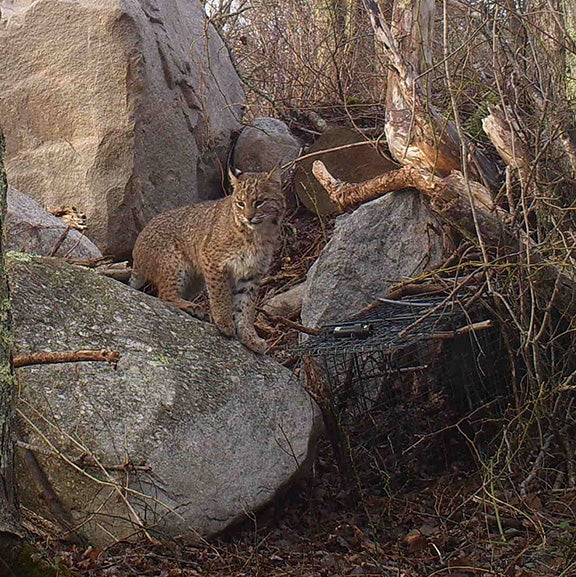KINGSTON, R.I. – September 7, 2017 – A University of Rhode Island researcher is asking Ocean State residents to report any sightings of bobcats in the state for ongoing studies of the habitat usage, distribution and population of the region’s only wild cat.
According to URI Research Associate Amy Mayer, bobcat numbers appear to be on the rise in the region, based on reported sightings and roadkilled animals collected in the last decade. But no formal research had been conducted on the animals until Mayer and Charles Brown, a wildlife biologist with the Rhode Island Department of Environmental Management, began studying them in 2015.
Since that time, they have captured three bobcats – one each in South Kingstown, Charlestown and Westerly – and tracked their daily movements for several months. One was subsequently struck and killed by a car, but the other two are still wandering South County.
Mayer said that reports of recent and regular sightings of bobcats in particular locations will help her identify the best sites to set up her traps.
“One of the cats we caught last season was an animal that a homeowner had seen on their property a bunch of times,” she said. “So we put a trap there and caught it on the first night. Having known locations like that is easier than having us blindly put out traps wherever we think looks good. Having records of where people see them is really useful.”
Bobcats are the most widely distributed feline in North America, where they live in deserts, mountains, prairies and coastal regions. Weighing up to 35 pounds, they eat a wide variety of small mammals and other prey. In Rhode Island they are believed to consume mostly rabbits, squirrels and rodents.
The animals have been sighted in nearly every community in mainland Rhode Island. The hotspots seem to be in South Kingstown, Westerly and Foster, but they are also known to occasionally travel through densely populated areas of Cranston, Warwick and West Warwick.
The purpose of Mayer’s bobcat research is to learn where they are found, how many reside in the state, what habitat they use and how widely they travel.
“Based on the sighting reports so far, we don’t think they’re super densely populated in the state at this time, but we know there are pockets where they seem to be common,” she said.
Mayer will begin trapping bobcats again in October. Each box trap will also have a motion-sensing camera to take photographs to document any animals that approach the trap but don’t enter.
“If we get good enough photos, we can pick out individual cats based on their spot patterns, and that will help us get a better handle on their population numbers,” she said.
Anyone who observes a bobcat in Rhode Island or captures a bobcat image on a trail camera is encouraged to report the sighting to Mayer through a form on her website at http://uriwildlifegenetics.org/bobcat-sighting or via email at agottfried@uri.edu.

